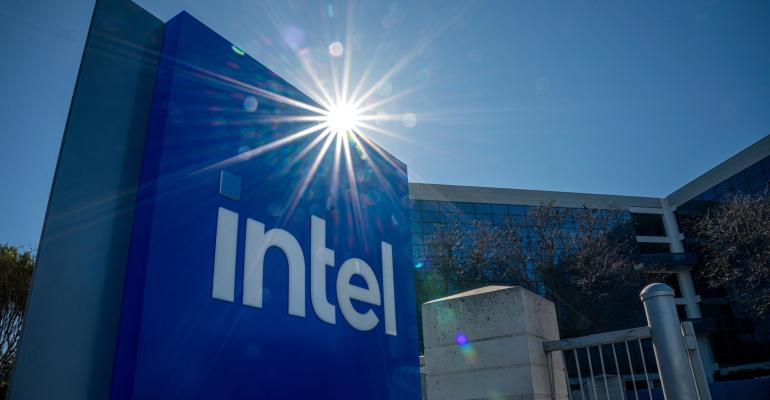(Bloomberg) -- Intel Corp. surged in late trading after predicting a return to sales growth in the fourth quarter, fueled by an improving personal computer market and a more competitive product line.
Sales in the period will be $14.6 billion to $15.6 billion, Intel said in a statement Thursday, compared with an average analyst estimate of $14.4 billion. Excluding certain items, profit will be 44 cents a share. Analysts had projected 31 cents, according to data compiled by Bloomberg.
The upbeat outlook shows growing momentum for Intel's turnaround efforts under Chief Executive Officer Pat Gelsinger. The company has said that the PC market, its biggest business unit by shipments, is through the worst of a historic slump caused by a buildup in inventory. Its server unit, though, is still struggling — hurt by a shift in customer spending toward chips made by Nvidia Corp.
Intel shares, already up 23% this year, jumped as much as 8.9% in extended trading following the announcement late Thursday. It was the third time in a row that investors applauded the company's quarterly report. That's helped Intel keep pace with a broader rally in chip-industry stocks this year, driven by optimism that a surge in artificial intelligence use will increase demand.
The quarter was a step forward in the company's plan to regain leadership of the chip industry and included the winning of new customers for its outsourced manufacturing division, Gelsinger told analysts on a call.
"While we're encouraged by our progress to date we know we have much more work in front of us," Gelsinger said.
Intel predicted that its adjusted gross margin — the portion of sales remaining after deducting the cost of production — will be 46.5% in the fourth quarter. That compares with an estimate of 44.2%. That measure is an indicator of how productive Intel's multibillion-dollar factory network is. At the height of Intel's powers, the gross margin was well over 60%.
Intel is now increasingly confident that — once it regains technological leadership in chip production — it will be able to restore its margins to that level, Chief Financial Officer Dave Zinsner said on the call.
In the third quarter, earnings came in at 41 cents a share on sales of $14.2 billion. Analysts had estimated profit of 21 cents and revenue of $13.5 billion.
Client computing, Intel's PC chip business, generated $7.87 billion in revenue last quarter. That compared with an estimate of about $7.4 billion. Data center sales were $3.8 billion, versus an average projection of $3.94 billion. That market is on course for annual shipments of about 270 million units and will ultimately grow to about 300 million units, Gelsinger said.
But Intel faces more competition in that market. Nvidia and Advanced Micro Devices Inc. are working on PC processors that use technology from Arm Holdings Plc, Bloomberg reported this week. The more crowded field shows that there's increasing excitement about the industry, Intel’s CEO said. Still, he doesn’t expect Arm technology to take a significant share of the market.
Gelsinger also praised the work of staff in Israel, where Intel has a major design center and factory. The company is also constructing a new plant there. Workers have kept the operations going despite the conflict with Hamas, he said. The chipmaker's production is near the town of Kiryat Gat, which is close to the Gaza border and near sites that suffered terrorist attacks.
He said Intel is unique in having factories across a broad set of locations, allowing it to mitigate the risk of disruptions.
Intel’s turnaround is still in the early stages. While the PC market is improving, sales remain down from where they were a year ago. And the company is playing catch-up with Nvidia in semiconductors that help power the development of powerful AI systems.
Gelsinger said that while data center operators have been spending more of their budgets on Nvidia chips, he expects them to shift back to other kinds of processors. Nvidia's so-called accelerators are good at training artificial intelligence but different types of processors, Intel's Xeons, will be needed to actually run the AI models and provide the services, he argued.
Gelsinger also has yet to announce big customers for his push into the so-called foundry industry, where manufacturers produce outsourced chips for other companies. Intel's CEO has launched an expensive effort to build factories around the world, aiming to lure clients — including rivals — to the program.
Without actually naming any customers, Gelsinger said he's ahead of schedule in terms of the client commitments and interest he's receiving. The effort is currently just a fraction of Intel's business, though. The foundry division had revenue of $311 million last quarter, compared with $78 million in the same period a year earlier.
For now, Intel's resurgence has largely been driven by customers restocking their inventory, rather than bigger shifts, according to KeyBanc Capital Markets analyst John Vinh.
"The results are good and we're seeing a near-term improvement," he said in an interview with Bloomberg Television. "The big milestones Pat has to show — and Intel has to show going forward — are on foundry services and AI."




